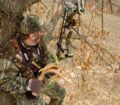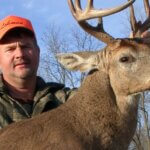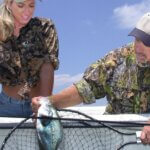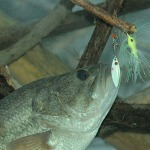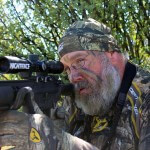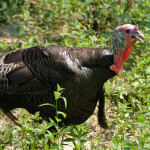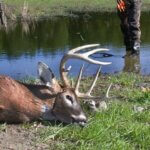Editor’s Note: A brown muzzle eased out of the thick cover as a deer’s eyes appeared. Finally a wide, high rack came into view. Cautiously, nervously, the buck took two steps into the road. A rifle reported. The buck stumbled and fell. The hunter had his trophy. Let’s look at some of the most-productive places where you can take a buck this hunting season.
 Trophy bucks often live in cattle country and can be taken by those who know how to hunt them. Because of the wide-open spaces, most deer hunters do not think of cattle country as deer country. But a deer-hunting friend of mine, who has grown-up in cattle country and has hunted the white-tailed deer there most of his life, explains. “Some of the biggest bucks in any region often will be found in cattle country, for several reasons. All the ingredients present in cattle country that put weight on cattle also put weight and antlers on deer, including an abundance of food, fertilized pastures and little or no harassment. “Just at daylight, big bucks will move from small heads of woods across pastures to thickets and bedding areas. Deer like to cross in the middles of pastures, where they have a lot of open space around them. The bucks feel secure in crossing these pastures, because they are rarely if ever shot at on these routes. Year after year, deer will travel the same trails through the middles of pastures they historically have used. By putting-out an attractant on the edges of these pastures where you can place a ground blind or a tree stand, you not only can lure the bucks out of the woods before they cross the pasture, the attractant also will increase your odds that the buck will stop and present a shot before he starts across the pasture. If you put a log soaked with liquid attractant on the edge of the trail crossing the pasture, you often can stop the deer at that log to give you an opportunity to take the shot.
Trophy bucks often live in cattle country and can be taken by those who know how to hunt them. Because of the wide-open spaces, most deer hunters do not think of cattle country as deer country. But a deer-hunting friend of mine, who has grown-up in cattle country and has hunted the white-tailed deer there most of his life, explains. “Some of the biggest bucks in any region often will be found in cattle country, for several reasons. All the ingredients present in cattle country that put weight on cattle also put weight and antlers on deer, including an abundance of food, fertilized pastures and little or no harassment. “Just at daylight, big bucks will move from small heads of woods across pastures to thickets and bedding areas. Deer like to cross in the middles of pastures, where they have a lot of open space around them. The bucks feel secure in crossing these pastures, because they are rarely if ever shot at on these routes. Year after year, deer will travel the same trails through the middles of pastures they historically have used. By putting-out an attractant on the edges of these pastures where you can place a ground blind or a tree stand, you not only can lure the bucks out of the woods before they cross the pasture, the attractant also will increase your odds that the buck will stop and present a shot before he starts across the pasture. If you put a log soaked with liquid attractant on the edge of the trail crossing the pasture, you often can stop the deer at that log to give you an opportunity to take the shot.
 When you hunt fence lines, learn where the deer are crossing them, since deer often have one particular place in the fence where they will cross. You may be able to see the trail where the deer are crossing or telltale signs in the wire. For instance, if the deer jump the fence, they’ll often leave white hair from their stomachs on the top strands of the wire. If a deer goes under the fence, you may see short brown hair from the deer’s back, indicating it has crawled under the fence. Your best chances for bagging a trophy buck probably will be when you locate a spot where the deer go under the fence. To stop a buck before he goes under or over a fence, create an attractant site with liquid or powder. Deer are much like a man who likes ice cream. If the ice cream shop is along the same route that the man drives regularly, there’s no reason for him not to stop at the ice-cream shop to get his ice cream. But if he has to go 6 or 8 blocks out of his way to go to an ice cream shop, he won’t frequent that ice-cream shop nearly as often. Therefore when you’re placing deer attractant, always put it at a site where the deer have shown you already that they want to travel.
When you hunt fence lines, learn where the deer are crossing them, since deer often have one particular place in the fence where they will cross. You may be able to see the trail where the deer are crossing or telltale signs in the wire. For instance, if the deer jump the fence, they’ll often leave white hair from their stomachs on the top strands of the wire. If a deer goes under the fence, you may see short brown hair from the deer’s back, indicating it has crawled under the fence. Your best chances for bagging a trophy buck probably will be when you locate a spot where the deer go under the fence. To stop a buck before he goes under or over a fence, create an attractant site with liquid or powder. Deer are much like a man who likes ice cream. If the ice cream shop is along the same route that the man drives regularly, there’s no reason for him not to stop at the ice-cream shop to get his ice cream. But if he has to go 6 or 8 blocks out of his way to go to an ice cream shop, he won’t frequent that ice-cream shop nearly as often. Therefore when you’re placing deer attractant, always put it at a site where the deer have shown you already that they want to travel.
Although big bucks will cross open pastures throughout the year, prior to the rut, they often will hold in small woodlots where they can find acorns and other browse and where they are protected by cover. Other spots where bucks often stay during daylight hours in cattle country will be in weeds beside ditches, thick cover on a small hill or any patch of cover in the middle of an open field. The bucks will remain in these places during daylight hours, because they can see danger approaching from any direction. To hunt thick cover in cattle country, you must identify the areas where the deer bed-down at daylight, know how to reach these spots with a favorable wind before daybreak and take a stand. If you don’t go to your stand under the cover of darkness, you will spook the buck you are trying to take.
 One of the ways to get those big bucks out of those thick-cover places during daylight hours is to put out a deer attractant on the edges of that thick cover. Then the buck can stay partially in the thick cover and still get to the attractant. Another option is to put the attractant upwind of the buck’s thick-cover hideout and attempt to lure him out of that thick cover early in the morning, late in the evening or in the middle of the day when few other hunters are hunting.
One of the ways to get those big bucks out of those thick-cover places during daylight hours is to put out a deer attractant on the edges of that thick cover. Then the buck can stay partially in the thick cover and still get to the attractant. Another option is to put the attractant upwind of the buck’s thick-cover hideout and attempt to lure him out of that thick cover early in the morning, late in the evening or in the middle of the day when few other hunters are hunting.
When you hunt small woods with open pastures on either side, you often can drive the deer out of the woodlots and into the openings where you can get a shot. However, to be successful, you must know which trail the deer will take out of the thick cover to cross the pasture, and then you must drive that woodlot more than once. Some hunters have learned that blocking one side of a small woodlot with human odor to fence the deer in and make them move in the direction of the stander is a productive means of hunting small heads of woods in cattle country.

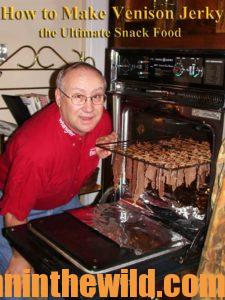 Once you take your deer, check out John E. and Denise Phillips’ book, “The Best Wild Game and Seafood Cookbook Ever” that features 350+ tried and true recipes, https://www.amazon.com/Best-Wild-Game-Seafood-Cookbook-ebook/dp/B00AN7GDW4. Also look at their cookbook, “Deer & Fixings” https://www.amazon.com/Deer-Fixings-Cook-Delicious-Venison-ebook/dp/B007L97HCW that contains 100+ recipes for preparing venison plus features more than 100 recipes for side dishes to accompany the venison. To receive your free book on “How to Make Venison Jerky,” go to https://www.emailmeform.com/builder/form/Ece3UZVcOo52cKPJcL.
Once you take your deer, check out John E. and Denise Phillips’ book, “The Best Wild Game and Seafood Cookbook Ever” that features 350+ tried and true recipes, https://www.amazon.com/Best-Wild-Game-Seafood-Cookbook-ebook/dp/B00AN7GDW4. Also look at their cookbook, “Deer & Fixings” https://www.amazon.com/Deer-Fixings-Cook-Delicious-Venison-ebook/dp/B007L97HCW that contains 100+ recipes for preparing venison plus features more than 100 recipes for side dishes to accompany the venison. To receive your free book on “How to Make Venison Jerky,” go to https://www.emailmeform.com/builder/form/Ece3UZVcOo52cKPJcL.

